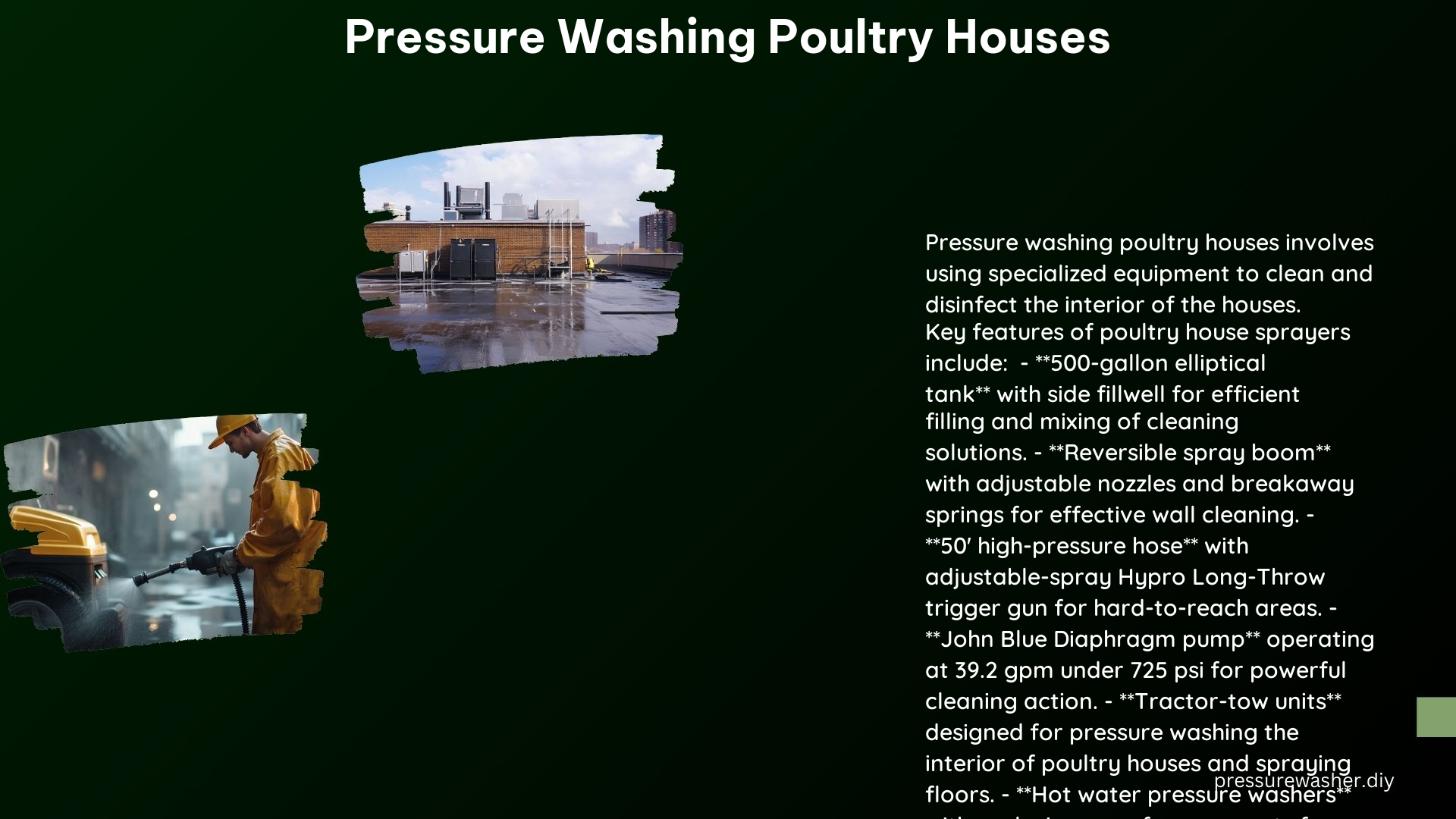Maintaining a clean and hygienic environment in poultry houses is crucial for the health and well-being of the birds, as well as the safety of the end products. Pressure washing is an essential process that helps to remove built-up dirt, debris, and pathogens from the surfaces of the poultry house. This comprehensive guide will provide you with the technical specifications, safety precautions, and best practices for pressure washing poultry houses effectively.
Recommended Frequency for Pressure Washing Tunnel Fans
Proper maintenance of the tunnel fans in a poultry house is crucial for ensuring optimal air circulation and ventilation. The recommended frequency for pressure washing the tunnel fans is:
- Frequency: Clean tunnel fans with the introduction of each new flock, especially when air speed certification is done. This is typically every 10 weeks in broiler production.
- Importance: Keeping the tunnel fans clean ensures that they operate at peak efficiency, providing the necessary air flow and ventilation for the birds. Buildup of dust, feathers, and other debris can significantly reduce the air speed and compromise the overall air quality in the poultry house.
Preparing a Poultry House for a Wash Down

Before the pressure washing process can begin, it is essential to properly prepare the poultry house. This includes:
- Clearing the Floor: Use a bobcat or similar machine to clear the floor of litter (chicken droppings, feathers, food waste, etc.) before the wash down. This is essential to prevent creating “chicken poop soup” during the wash, which can be difficult to clean up and can lead to the spread of pathogens.
- Removing Equipment: Disassemble and remove any equipment or fixtures that can be easily taken out of the poultry house, such as feeders, drinkers, and nesting boxes. This will allow for more thorough cleaning of the surfaces.
- Protecting Electrical Components: Ensure that all electrical components, such as control panels and wiring, are properly protected from the high-pressure water spray to prevent damage or short-circuits.
Safety Precautions
Pressure washing poultry houses can be a hazardous task, and it is crucial to take the necessary safety precautions to protect both the operator and the equipment. These include:
- Explosion Proof Equipment: Use explosion-proof pressure washers to ensure safety, especially in areas with high risk of explosion due to the presence of flammable materials, such as dust or gases.
- Personal Protective Equipment (PPE): Wear appropriate PPE, such as gloves, safety glasses, and a face mask, to protect yourself from the high-pressure spray and any chemicals used during the washing process.
- Proper Ventilation: Ensure that the poultry house is well-ventilated during the pressure washing process to prevent the buildup of harmful fumes or vapors.
- Lockout/Tagout Procedures: Implement proper lockout/tagout procedures to ensure that the equipment is properly isolated and cannot be accidentally activated during the cleaning process.
Technical Specifications
To ensure the most effective and efficient pressure washing of poultry houses, it is important to use the right equipment and tools. The following technical specifications are recommended:
Pump
- Pump: A John Blue Diaphragm pump operating at 39.2 gpm under 725 psi is suitable for pressure washing poultry houses.
- Advantages: The John Blue Diaphragm pump is designed to handle the high-pressure and high-volume requirements of poultry house cleaning, while also being resistant to corrosion and wear from the harsh chemicals and environments.
Hose and Spray Gun
- Hose: Use a 50′ high-pressure hose to provide the necessary reach and maneuverability for cleaning the various surfaces and hard-to-reach areas of the poultry house.
- Spray Gun: Equip the pressure washer with an adjustable-spray Hypro Long-Throw trigger gun, which allows for precise control and targeting of the water spray.
- Advantages: The long-throw trigger gun enables the operator to clean walls, ceilings, and other elevated surfaces without the need for ladders or scaffolding, improving efficiency and safety.
Trailer
- Trailer: A single-axle spray trailer with a 500-gallon elliptical tank and a Reelcraft reel mounted on a 180-degree locking swivel is a suitable setup for pressure washing poultry houses.
- Advantages: The large tank capacity allows for extended cleaning sessions without the need for frequent refilling, while the 180-degree swivel reel provides added flexibility and maneuverability when maneuvering the pressure washer hose.
Additional Tips
To further enhance the effectiveness and efficiency of pressure washing poultry houses, consider the following additional tips:
- Use Hot Water: Hot water pressure washers are more effective for cleaning and disinfecting poultry houses, especially when used in conjunction with safe pressure washer chemicals and detergents. The heat helps to break down and remove stubborn dirt, grease, and organic matter.
- Adjustable Nozzles: Equip the pressure washer with adjustable nozzles that can be used to clean walls, ceilings, and floors effectively. The ability to adjust the spray pattern and intensity can help to reach and clean hard-to-access areas.
- Proper Rinsing: Ensure that all surfaces are thoroughly rinsed after the initial washing to remove any remaining dirt, debris, or chemical residues. This helps to prevent the buildup of contaminants and ensures a clean, disinfected environment.
- Drying and Disinfection: After the pressure washing process, allow the poultry house to dry completely before introducing a new flock. Consider using a disinfectant spray or fog to further sanitize the environment and kill any remaining pathogens.
By following these technical specifications, safety precautions, and best practices, you can ensure that your poultry houses are thoroughly cleaned and disinfected, promoting the health and well-being of your birds and the safety of your end products.
